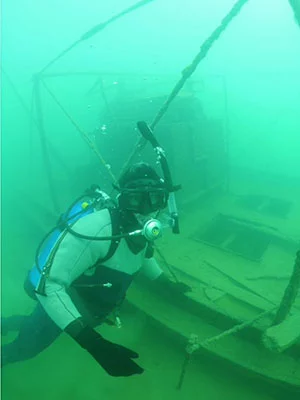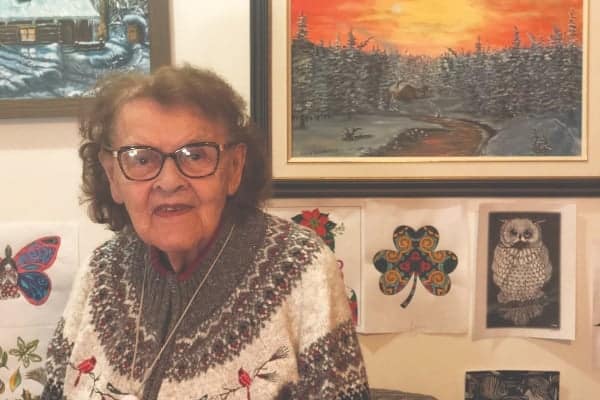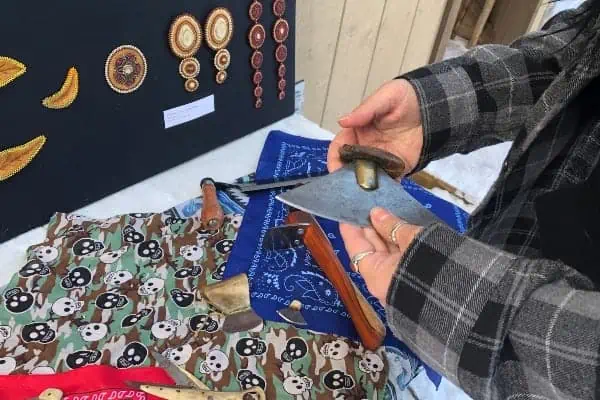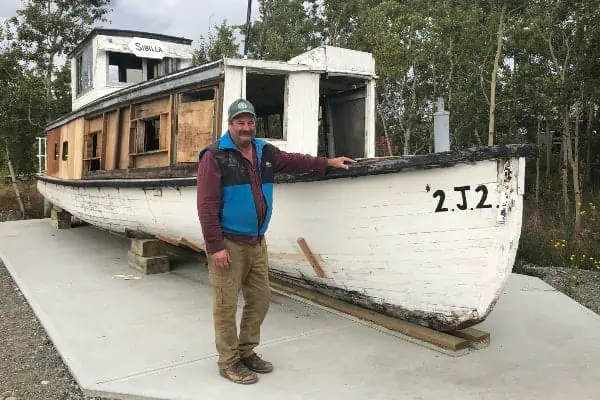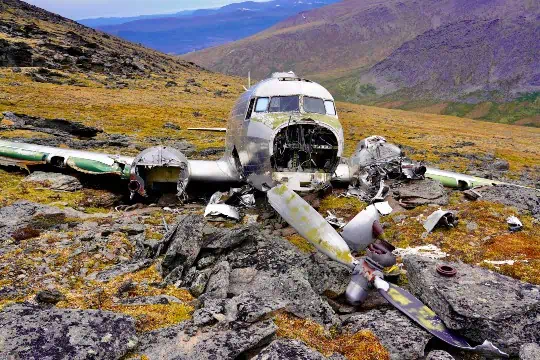Doug Davidge finds lost things.
Over the course of more than three decades in the Yukon, Davidge has been known to find things that people know are missing–such as the A.J. Goddard, a steamboat that vanished in Lake Laberge in 1901–and things that people might not even realize are lost. For example, a few years ago while hunting in southern Yukon, he spotted a pair of teardrop-shaped stone tools called bifaces, which were designed to fit comfortably against the palm of a hand and used to scrape hides, cut bone, or dig. These tools date from hundreds or even thousands of years ago. One biface was settled in the sand at his feet and the other was lying just about a metre away.
“They were completely exposed and visible, if you know what to look for,” said Davidge. “There is a rich cultural history in the Yukon and we see more and more of it every year.”
When he finds cultural artifacts, such as the bifaces, Davidge documents the site and reports it to ensure Yukon and First Nation governments know where the objects are located. Then those governments decide whether the objects are best retrieved or left where they were found.
“We remember the Klondike Gold Rush and the Second World War as big events here, but they cover such a short timeframe that they really don’t represent Yukon history,” said Davidge. “That’s why the cultural history, which can date back 8,000 to 10,000 years, is obviously so important.”
Davidge came to the Yukon from the Northwest Territories in the early 1980s, and worked for decades as an environmental specialist with Environment Canada. The job required that he spend a lot of time working outdoors. It took him to some of the more remote places in the Yukon, Northwest Territories and northern B.C.
“I was always grateful to be able to do that kind of work because I got to experience so many places that many people never get to see,” said Davidge. “I spent a lot of time in the field and so I started keeping an eye out for things. Sometimes things are just lying on the ground. The Yukon really doesn’t accumulate a lot of dirt and dust to cover things up, so things can just sit in one spot for 1,000 years, up on a hillside or on a beach,” he said.
Other times, to find these remnants from the past, you have to know where to look. And Davidge has identified his choice spots for chance discoveries. “I look for places that have a good view of a valley, exposed hillsides, or ground that’s been disturbed from wind erosion, water erosion, or even human activity,” he said. “Small disturbances will sometimes expose cultural artifacts that are thousands of years old.”
In the mid-1980s, Davidge took his search from land to water and began assisting archaeologists on underwater dives to document hidden heritage sites. Some of the first heritage-related dives he helped with were at the Venus Mine site in the Windy Arm mining district, right off the South Klondike Highway between Carcross and Log Cabin. Davidge and archaeologists explored the underwater base of the old mill, a wooden structure built in 1908, which runs down the side of Montana Mountain and into Tagish Lake.
“Generally, you’ll find a lot of debris at those old mine sites (including) old bottles, plates, pieces of metal,” he said.
While gaining experience diving at mining sites and former settlements such as Canyon City, the vivid stories of underwater shipwrecks in Yukon’s waterways sparked Davidge’s imagination. He began searching for historical wrecks.
“It was the chance of discovering something different or new that drew me,” he said. “We could spend weeks or months diving and not see anything of interest and then, all of a sudden, oh, there’s half a sternwheeler hull just sitting there on the lake bottom.”
One wreck that eluded Davidge and other divers for years was the A.J. Goddard, a Klondike Gold Rush-era sternwheeler that foundered during an early winter storm on Lake Laberge in October 1901.
“For 20 years we’d been going up one side of it and down the other side of it and never actually pinpointing it,” said Davidge.
At just 15 metres long and three metres in width, the Goddard was small for a sternwheeler. That made it easy to miss while surveying a large lake. In the end, it was exactly where it should have been, about 200 metres from a small outcrop of land named Goddard Point. One day while working on Laberge, Davidge and a team from the Yukon River Steamboat Survey saw a promising reading on the boat’s fish-finding sonar. He noted the GPS coordinates, and later returned to the site to confirm the find. Finally, on July 5, 2008, Davidge dropped a video camera into the water and spotted a metal structure. After drifting over the site a few more times, decking, machinery and a windlass came into view. Davidge realized that this was it. He’d found the missing ship. The Goddard was sitting upright on the lake bed, still full of tools, cooking utensils and personal effects from the crew.
PHOTO: Don Reid/Institute of Nautical Archeology
Over the next few years and hundreds of dives to the wreck site, artifacts were examined and a cross-section of interesting objects were acquired for the Government of Yukon archaeological collection. Other objects were examined and then returned to the site and put back where they were found. The Goddard was designated a Yukon Historic Site in 2010. It is the only remaining sternwheeler of its kind.
“For me, it was really interesting to be able to be a part of it,” said Davidge. “But of course, once you find something that’s viewed with that much importance by the archeological community, it takes on its own life.”
In 2011, National Geographic produced a film on the Goddard. Within hours of it showing on American television, Davidge was receiving phone calls from relatives of the men who were on that boat. In fact, two families came to the Yukon to see Laberge and the items salvaged from the wreckage.
“We had a woman in her 80s and her son come to the Yukon and you could tell that the story of the Goddard had been passed down in their family for generations. That was the boat where the great-grandfather died,” said Davidge.
“There’s no real monetary reward in this work for me, but to be able to share this find with the families, that’s my reward.”
[box] Editors note: Archaeological and historical sites are protected from disturbance under the Yukon Historic Resources Act (Archaeological Site Regulations). No artifacts may be removed from an archaeological or historic site without a permit.[/box]

